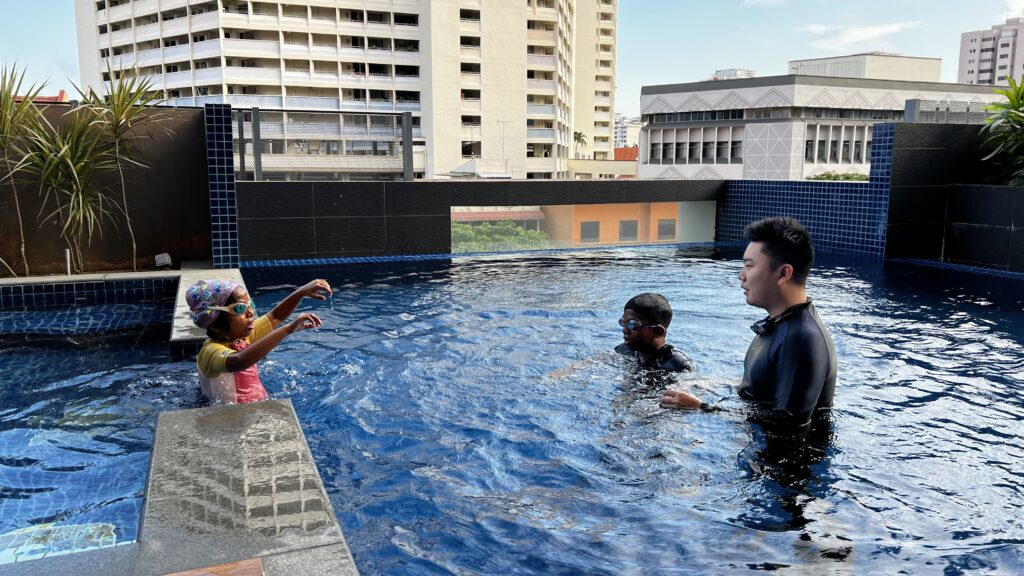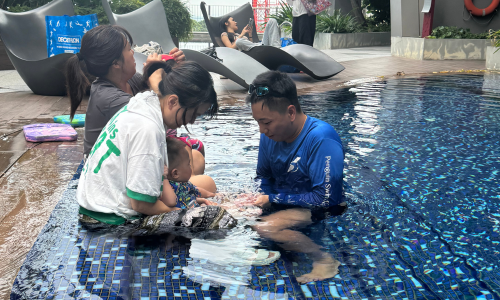How We Use Music & Rhymes in Swim Lessons
IntroductionAt Penguin Swim School, we believe swimming is about more than just strokes and kicks. It’s about confidence, enjoyment, and...
Penguin Swim School | Best Swimming School in Singapore | Expert Swimming lessons in Singapore

Watching your child grow more confident in the water is one of the most rewarding experiences a parent can have. But like any new skill, swimming progresses in stages—and it helps to recognise the signs that show your child is on the right path.
At Penguin Swim School, we believe in celebrating every splash, stroke, and kick. This guide highlights 8 key milestones your little swimmer should aim to reach, giving you a clear understanding of their progress in both skill and safety.
Before learning strokes or techniques, your child must first feel comfortable and relaxed in the water. This is the emotional foundation for all swimming development.
Willingly entering the pool
Smiling, splashing, and playing during lessons
Tolerating water on the face without distress
At this point, it’s not about structure—it’s all about fun, trust, and familiarity.
Blowing bubbles and going underwater shows your child is beginning to control their breath and adapt to water on their face—vital skills for safe swimming.
Entering face-first without hesitation
Blowing bubbles through the mouth or nose
Holding breath briefly while submerged
This milestone helps your child become water-aware and breathing-smart.
Floating demonstrates that your child is developing a sense of body control and balance in the water—crucial for both swimming and survival.
Floating on their back with minimal support
Performing a front starfish float with the face in water
Relaxing their body instead of tensing up
Mastering floating is key to building confidence and water safety.
Once floating feels natural, children begin learning how to move purposefully in the water using their arms and legs.
Kick their legs in a straight, rhythmic motion
Paddle their arms in a coordinated forward movement
Start combining limb movement with basic breath control
At Penguin Swim School, we call this the “movement magic” phase—where swimming truly starts to take shape!
This is a huge moment for many children—and their proud parents! Swimming a short distance independently shows they’ve combined several key skills into an effective, functional swim.
Swimming 3–5 metres without assistance
Coordinating arms and legs together
Breathing by lifting the head or turning to the side
At this stage, your child is beginning to show the traits of a genuine swimmer.
Now it’s time to introduce formal strokes such as freestyle and backstroke. This milestone marks the transition from basic movement to technique and efficiency.
Move from doggy paddle to proper stroke shapes
Learn arm recovery and breathing timing
Explore breaststroke and elementary backstroke
Each child learns at their own pace—but this is where the true transformation into a skilled swimmer begins.
Being a strong swimmer isn’t just about physical ability—it’s also about environmental awareness. Children need to understand pool rules and safe behaviours.
Knowing where it’s safe to enter and exit the pool
Following instructions from instructors
Respecting others’ space in the water
This milestone is essential for accident prevention and for developing lifelong water safety awareness.
By now, your child is not just swimming—they’re learning how to stay safe in real-world situations. Treading water is a core survival skill.
Keeping the head above water without assistance
Staying afloat for 30 seconds or longer
Switching between floating and treading
These essential skills offer peace of mind and are a central focus of the SSI curriculum at Penguin Swim School.
At Penguin Swim School, we follow a skill-based, age-appropriate approach that supports children at each stage of their swimming journey. Every lesson is designed to guide them through these milestones naturally and enjoyably.
Visual achievement markers for motivation
Personalised teaching methods to suit each swimmer
Safe, low-pressure environments that encourage confidence
Our experienced instructors use the Swim Schools International (SSI) system to ensure every swimmer is supported from their first splash to full stroke mastery.
From blowing bubbles to mastering backstroke, each swimming milestone plays an important role. It’s not just about developing technique—it’s about raising confident, safe, and happy individuals.
Whether your child is starting their journey or already progressing through levels, they’re in trusted, professional hands with the team at Penguin Swim School.
🌐 Website: www.penguinswimschool.sg
📞 Call: +65 8909 4656
💬 WhatsApp: https://wa.me/6589094656
📧 Email: swim@penguinswimschool.sg
IntroductionAt Penguin Swim School, we believe swimming is about more than just strokes and kicks. It’s about confidence, enjoyment, and...
IntroductionAt Penguin Swim School, we believe swimming is more than just a life skill – it’s a journey of confidence,...
IntroductionAt Penguin Swim School, we believe swimming is not only a life-saving skill but also a wonderful opportunity for children...

Do you enjoy the water? Are you passionate about teaching and helping others become more confident swimmers? A career as a certified swim instructor in Singapore may be just the right fit for you.
Whether you’re teaching children, adults, or competitive swimmers, the need for qualified instructors is increasing every year. But how does one transition from enthusiastic swimmer to certified instructor?
In this article, we break down the 5 simple steps to becoming a certified swim instructor in Singapore—from qualifications and education to teaching opportunities and career advancement.
Establish a Good Swimming Foundation
You need to be a strong swimmer before you can teach others. This means mastering all four fundamental strokes—freestyle, breaststroke, backstroke, and butterfly—as well as essential skills like treading water, diving, and breathing techniques.
Take higher-level swim lessons
Participate in a local swim club or team
Practise consistently to improve endurance and technique
Consider observing experienced coaches or volunteering at swim schools to gain insight into how lessons are structured and conducted.
As a swim instructor, your students’ safety is your top priority. That’s why holding up-to-date Cardiopulmonary Resuscitation (CPR) and Basic First Aid certifications is essential.
Where to Get Certified
Singapore Red Cross
St John Ambulance Singapore
Singapore First Aid Training Centre (SFATC)
These certifications typically remain valid for two years and must be renewed to maintain your instructor credentials.
Many swim instructor training programmes require a valid CPR certificate before registration, so plan ahead and get certified early.
To become a swimming instructor in Singapore, you must obtain certification from a recognised authority. The most commonly accepted certifications are from SwimSafer and AUSTSWIM.
Developed by Sport Singapore
Ideal for teaching children and youth
Covers water safety, instructional methods, and assessment procedures
Internationally recognised
Comprehensive training for teaching beginners, water safety, and stroke development
Offers specialised upgrades for teaching babies, adults, or individuals with special needs
What You’ll Learn
Planning and delivering effective swimming lessons
Managing class safety
Communicating with diverse age groups
Identifying and correcting technique issues
Choose the certification that best suits the age group or type of swimmer you wish to teach—whether children, adults, or special populations.
After certification, it’s time to turn theory into practice. Most swim centres and schools expect new teachers to go through a probation or training period in which they support actual classes.
Local swim schools (such as Penguin Swim School)
Community centres
Private coaching with supervision
National sports clubs or pools
Teaching with experienced mentors assists you in developing your teaching approach, dealing with class behavior, and gaining confidence.
Begin with beginner classes to develop your confidence before moving to advanced or specialized sessions.
After training and gaining some experience, it’s time to begin teaching on your own or at a swim academy.
Organized setting, regular schedules, and marketing help.
Example: Penguin Swim School
More independence and higher earnings, but you’ll be responsible for your own students, scheduling, and advancement.
Instruct special needs children, babies, or competitive swimmers with additional certifications.
Continue to expand your knowledge and take refresher workshops or courses to update your skills with the newest teaching techniques and safety guidelines.
Bonus: Qualities of an Excellent Swim Instructor
While certification is necessary, being an excellent instructor also involves:
Patience and encouragement
Clear communication
Strong observation skills
Enthusiasm for teaching and aquatic safety
Capacity to modify lessons for diverse ages and learning styles
Your attitude, energy, and consistency will significantly impact your students’ learning experience.
At Penguin Swim School, we provide a supportive and professional setting for instructors and students alike. Whether you are newly certified or have years of coaching experience, becoming part of our team means:
Flexible working hours
Mentorship and professional growth
Safe, child-friendly learning spaces
Growth and specialization opportunities
Working with a team that is passionate about fun, skill, and safety
We’re always on the lookout for passionate, certified swimming instructors to join our team.
It’s a fulfilling experience becoming a certified swimming instructor in Singapore. With proper training, safety certifications, and experience, you can convert your passion for the water into a rewarding and flexible professional life.
Whether you’re looking to teach children how to float for the first time or help adults conquer their fear of water, the opportunity to make a difference is real—and deeply impactful.
Take your first step with Penguin Swim School.
We’ll help guide your journey from passionate swimmer to inspiring instructor.
🌐 Website: www.penguinswimschool.sg
📞 Call: +65 8909 4656
💬 WhatsApp: https://wa.me/6589094656
📧 Email: swim@penguinswimschool.sg
IntroductionAt Penguin Swim School, we believe swimming is about more than just strokes and kicks. It’s about confidence, enjoyment, and...
IntroductionAt Penguin Swim School, we believe swimming is more than just a life skill – it’s a journey of confidence,...
IntroductionAt Penguin Swim School, we believe swimming is not only a life-saving skill but also a wonderful opportunity for children...
WhatsApp us
